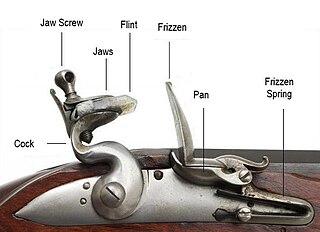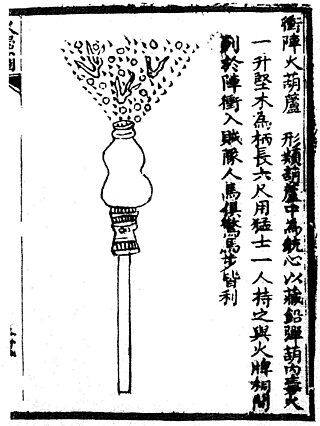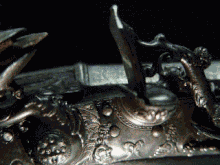
The percussion cap or percussion primer, introduced in the early 1820s, is a type of single-use percussion ignition device for muzzle loader firearm locks enabling them to fire reliably in any weather condition. Its invention gave rise to the cap lock mechanism or percussion lock system which used percussion caps struck by the hammer to set off the gunpowder charge in rifles and cap and ball firearms. Any firearm using a caplock mechanism is a percussion gun. Any long gun with a cap-lock mechanism and rifled barrel is a percussion rifle. Cap and ball describes cap-lock firearms discharging a single bore-diameter spherical bullet with each shot.
A muzzleloader is any firearm in which the user loads the projectile and the propellant charge into the muzzle end of the gun. This is distinct from the modern designs of breech-loading firearms, in which user loads the ammunition into the breech end of the barrel. The term "muzzleloader" applies to both rifled and smoothbore type muzzleloaders, and may also refer to the marksman who specializes in the shooting of such firearms. The firing methods, paraphernalia and mechanism further divide both categories as do caliber.

In firearms terminology, an action is the functional mechanism of a breech-loading firearm that handles the ammunition cartridges, or the method by which that mechanism works. Actions are technically not present on muzzleloaders, as all those are single-shot firearms with a closed off breech with the powder and projectile manually loaded from the muzzle. Instead, the muzzleloader ignition mechanism is referred to as the lock.

Flintlock is a general term for any firearm that uses a flint-striking ignition mechanism, the first of which appeared in Western Europe in the early 16th century. The term may also apply to a particular form of the mechanism itself, also known as the true flintlock, that was introduced in the early 17th century, and gradually replaced earlier firearm-ignition technologies, such as the matchlock, the wheellock, and the earlier flintlock mechanisms such as the snaplock and snaphaunce.

A wheellock, wheel-lock, or wheel lock is a friction-wheel mechanism which creates a spark that causes a firearm to fire. It was the next major development in firearms technology after the matchlock and the first self-igniting firearm. Its name is from its rotating steel wheel to provide ignition. Developed in Europe around 1500, it was used alongside the matchlock and later the snaplock (1540s), the snaphance (1560s), and the flintlock.

The flintlock mechanism is a type of lock used on muskets, rifles, and pistols from the early 17th to the mid-19th century. It is commonly referred to as a "flintlock". The term is also used for the weapons themselves as a whole, and not just the lock mechanism.

A ranged weapon is any weapon that can engage targets beyond hand-to-hand distance, i.e. at distances greater than the physical reach of the user holding the weapon itself. The act of using such a weapon is also known as shooting. It is sometimes also called projectile weapon or missile weapon because it typically works by launching solid projectiles ("missiles"), though technically a fluid-projector and a directed-energy weapon are also ranged weapons. In contrast, a weapon intended to be used in hand-to-hand combat is called a melee weapon.

Miquelet lock is a modern term used by collectors and curators for a type of firing mechanism used in muskets and pistols. It is a distinctive form of snaplock, originally as a flint-against-steel ignition form, once prevalent in the Spanish, Portuguese, and Ottoman empires, Italy, North Africa, and the Balkans from the late 16th to the mid-19th century.

The lock of a firearm is the mechanism used to initiate firing. It is a historical term, in that it generally refers to such mechanisms used in muzzle-loading and early breech-loading firearms. Side-lock refers to the type of construction, in which the individual components of the mechanism are mounted either side of a single plate. The assembly is then mounted to the stock on the side of the firearm. In modern firearm designs, the mechanism to initiate firing is generally constructed within the frame or receiver of the firearm and is referred to as the firing or trigger mechanism.

A snaplock is a type of lock for firing a gun or is a gun fired by such a lock.
The flash pan or priming pan is a small receptacle for priming powder, found next to the touch hole on muzzle-loading guns. Flash pans are found on gonnes, matchlocks, wheellocks, snaplocks, snaphances, and flintlocks.

A culverin was initially an ancestor of the hand-held arquebus, but later was used to describe a type of medieval and Renaissance cannon. The term is derived from the antiquated "culuering" and the French "couleuvrine" From its origin as a hand-held weapon it was adapted for use as artillery by the French in the 15th century, and for naval use by the English in the 16th century. The culverin as an artillery piece had a long smoothbore barrel with a relatively long range and flat trajectory, using solid round shot projectiles with high muzzle velocity.

The frizzen, historically called the "hammer" or the steel, is an "L"-shaped piece of steel hinged at the front used in flintlock firearms. The frizzen is held in one of two positions, opened or closed, by a leaf spring. When closed, it is positioned over the flash pan so as to enclose a small priming charge of black powder next to the flash hole that is drilled through the barrel into which the main charge has been loaded. When the trigger is pulled, the hammer or cock which includes a shaped piece of flint held in a set of jaws with a scrap of leather or thin piece of lead, snaps forward causing the flint to scrape downward along the frizzen's face, throwing it forward into the open position and exposing the priming powder. The flint scraping along the steel causes a shower of sparks to be thrown into the pan, thereby igniting the priming powder therein and sending flames through the touch hole, which in turn ignites the main charge of black powder in the breech of the barrel, driving the projectile out of the muzzle.

The hammer is a part of a firearm that is used to strike the percussion cap/primer, or a separate firing pin, to ignite the propellant and fire the projectile. It is so called due to the fact that it resembles a hammer in both form and function. The hammer itself is a metal piece that forcefully rotates about a pivot point.

A handgun is a firearm designed to be usable with only one hand. It is distinguished from a long gun which needs to be held by both hands and braced against the shoulder. Handguns have shorter effective ranges compared to long guns, and are much harder to shoot accurately. While most early handguns are single-shot pistols, the two most common types of handguns used in modern times are revolvers and semi-automatic pistols, although other handguns such as derringers and machine pistols also see infrequent usage.

The history of firearms begins in 10th-century China, when bamboo tubes containing gunpowder and pellet projectiles were mounted on spears to make portable fire lances, operable by one person. This was later used effectively as a shock weapon in the Siege of De'an in 1132. In the 13th century, fire lance barrels were replaced with metal tubes and transformed into metal-barreled hand cannons. The technology gradually spread throughout Eurasia during the 14th century and evolved into flintlocks, blunderbusses, and other variants. The 19th and 20th centuries saw an acceleration in this evolution, with the introduction of the magazine, belt-fed weapons, metal cartridges, and the automatic firearm. Older firearms typically used black powder as a propellant, but modern firearms use smokeless powder or other propellants. Most modern firearms have rifled barrels.

The Kalthoff repeater was a type of repeating firearm that was designed by members of the Kalthoff family around 1630, and became the first repeating firearm to be brought into military service. At least nineteen gunsmiths are known to have made weapons following the Kalthoff design. Some early Kalthoff guns were wheellocks, but the rest were flintlocks. The capacity varied between 5 and 30 rounds, depending on the style of the magazines. A single forward and back movement of the trigger guard, which could be done in 1–2 seconds, readied the weapon for firing. The caliber of Kalthoff guns generally varied between 0.4–0.8 in (10–20 mm), though 0.3 in (7.6 mm) caliber examples also exist.

A doglock is a type of lock for firearms that preceded the 'true' flintlock in rifles, muskets, and pistols in the 17th century. Commonly used throughout Europe in the late seventeenth century, it gained popular favor in the British and Dutch military. A doglock carbine was the principal weapon of the harquebusier, the most numerous type of cavalry in the armies of the Thirty Years' War and English Civil War era. Like the snaphance, it was largely supplanted by the flintlock.

The Moukahla or moukalla was a type of musket widely used in North Africa, produced by many tribes, clans and nations.
In firearms and artillery, the primer is the chemical and/or device responsible for initiating the propellant combustion that will propel the projectiles out of the gun barrel.
Brian Godwin, The English Snaphance Lock, London Park Lane Arms Fair catalog, Spring 2006, and Classic Arms and Militaria Magazine, volume XVI Issue 1, page 48





















